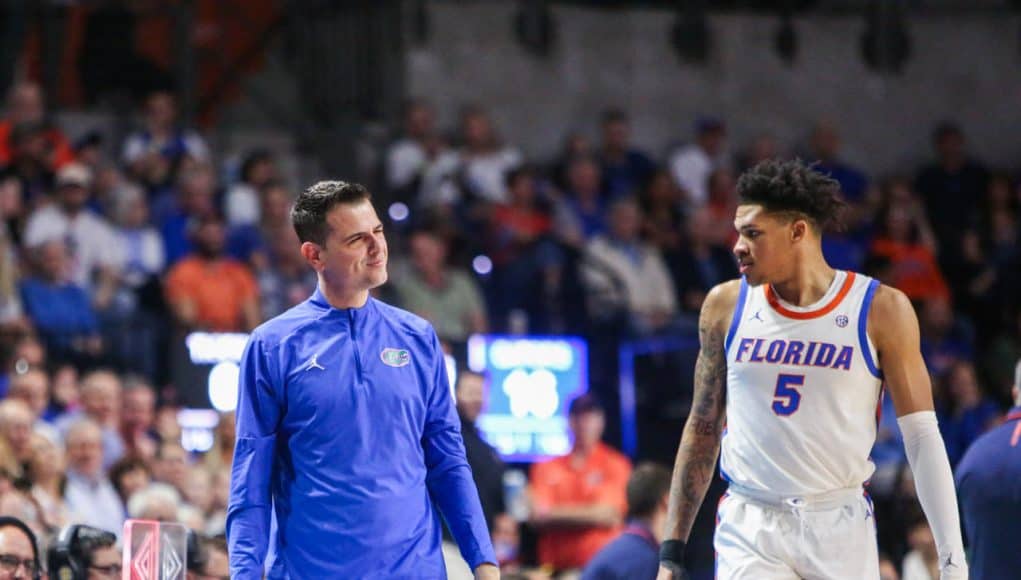Entering the 2024-25 season Florida’s coaching staff was determined to drastically improve the defense from the year prior and so far we’re seeing that goal come to fruition.
According to KenPom’s adjusted defensive efficiency metric, the gold standard for evaluating defense these days, the Gators finished the 2023-24 season at a disappointing 94th nationally.
This year, that number is all the way up to 22nd entering, dare I say–elite status.
Bringing in defensive-minded players like Alijah Martin, Reuben Chinyelu, and Sam Alexis have played a big role in this but there have also been some fundamental changes in the schematics which I laid out in a previous article a few days ago here at Gator Country. That article touched on the major points of what has changed about Florida’s defense, but after the Gators completely suffocated Arizona State at Hoopsgiving in Atlanta there was another element that needed to be discussed and that will be the purpose of today’s article.
That major element–Florida’s pick and roll defense.
When it comes to any defensive structure one of the biggest building blocks is how you’re going to guard pick and rolls. For the last decade the pick and roll has accounted for 25-30% of all offensive possessions in college basketball (according to data firm Synergy Sports) and that means if you’re not able to contain these actions you’re going to be giving up a lot of points.
Looking at how Florida has crafted their 22nd ranked defense this year one of the main improvements has been when it comes to pick and roll defense. Right now they are 41st in the country in pick and roll defense, and given that this isn’t an adjusted number based on quality of competition they have to be extremely happy with that number.
Before we talk about how Florida is guarding pick and rolls this year, we should talk about what they did last season. Prior to the year, Florida’s coaching staff had designed their defense entirely around taking away three-point shot opportunities and naturally that extended to the way they guarded pick and rolls. The ball handler’s defender would chase the ball handler overtop of the screen in order to take away pull up opportunities, while the big man guarding the screener would drop into the paint to take away the drive. Florida would do everything possible to not involve the other three defenders on the floor which allowed them to stay at home on shooters taking away the opportunity for the catch and shoot threes you often see created out of pick and rolls. While it had the intended effect of taking away threes, Florida allowed ball handlers to get a head of steam going towards the rim where they could finish or dump the ball off to rolling bigs for dunks given the lack of a help from a third defender.
Fast forward to this year where things have changed. The Gators have realized that protecting the rim is much more valuable and have now heavily involved the players on the “two side” (simply the side of the floor with two players on it during the pick and roll).
Let’s play out two of the scenarios.
As the ball handler comes off the screen if he is driving towards the side of the floor with two players, Florida is making the higher of the two players take two strides towards the middle of the floor (almost touching the paint) in order to stunt at the ball handler and try to take his dribble away. This opens up an easy short pass to the wing for a possible three (the kind of shots Florida was allergic to giving up last year) but if the stunt can cause the ball handler to pick up the ball early, the defender still has an opportunity to get a great close out on the shooter.
Now, the other scenario. If the ball handler is going towards the “single side” with just one player, the Gators will now “tag” the roll (when a help defender momentarily rotates to a second man to take away a passing opportunity) for a moment with the high player on the two side before he passes him off to the lower player on the two side who completes the tag. If that sounds a bit complex, let me simplify it–both players on the two side are now moving toward the middle of the lane to take away an opportunity for the roll man to receive a pass, and once that roller has run past them the defenders return to their check.
Once again, this is about the opposite of what Florida wanted to do last year when they would want these players to stay on shooters. This is a more aggressive scheme–but it’s working. Arizona State put the Gators in a ton of high ball screen situations and Florida completely nullified the attack with this pick and roll defensive system and it’s a huge reason why the Sun Devils were so stagnant offensively.
So far the Gators are yet to play a particularly talented offensive team (Arizona State is 74th nationally) so the system hasn’t been tested at a high level, but it should be a scheme that works as the Gators go up in talent. Last year Florida’s conservative drop pick and roll coverage worked great against lesser opponents but struggled against the talented guards of the SEC, and the scheme this year will provide much more support against these scorers while also taking away the lob opportunities for athletic 7-footers.
It’s still early, but so far this major defensive change has worked masterfully and the Gators will hope it carries through as they face their toughest test yet in North Carolina. Now that you’ve learned a bit more about Florida’s defense, look out for these concepts the next time you see the Gators play.


